#cynodictis
Text

timeline of the evolution of the dog spanning over 50~ million years 🌿
(not 100% accurate but I tried my best)
#dog#dogs#canine#paleo art#evolution#wolf#dire wolf#miacis#cynodictis#aenocyon#tomarctus#canis lupus#canis familiaris#grey wolf#timeline#extinct#extinct animals#extinct species#dog illustration#dog drawing#animal art#illustration#art#artists on tumblr#comics#doodle#illustrator#artist#digital art#animal illustration
569 notes
·
View notes
Text

Cynodictis. From The First Mammals, written/illustrated by William E. Scheele. 1955.
415 notes
·
View notes
Note
Could we possibly get Cynodictis added to the roster for paleo pixels?
Absolutely! This guy was fun to draw, very lanky.

This is part of an ongoing series I'm doing called Paleo Pixels! If you wanna leave a suggestion for a paleo creature to draw feel free to send in an ask though it might take me a bit to get to yours!
#paleo pixels#paleontology#paleo pixels suggestion#pixel art#my art#digital art#paleoart#paleo art#cynodictis#image description in alt#paleoblr
47 notes
·
View notes
Link
0 notes
Text
The History of Dogs
Mammal
Dog, (Canis lupus familiaris), domestic mammal of the family Canidae (order Carnivora). It is a subspecies of the gray wolf (Canis lupus) and is related to foxes and jackals. The dog is one of the two most ubiquitous and most popular domestic animals in the world (the cat is the other). For more than 12,000 years it has lived with humans as a hunting companion, protector, object of scorn or adoration, and friend.

The dog evolved from the gray wolf into more than 400 distinct breeds. Human beings have played a major role in creating dogs that fulfill distinct societal needs. Through the most rudimentary form of genetic engineering, dogs were bred to accentuate instincts that were evident from their earliest encounters with humans. Although details about the evolution of dogs are uncertain, the first dogs were hunters with keen senses of sight and smell. Humans developed these instincts and created new breeds as need or desire arose.

Dogs are regarded differently in different parts of the world. Characteristics of loyalty, friendship, protectiveness, and affection have earned dogs an important position in Western society, and in the United States and Europe the care and feeding of dogs has become a multibillion-dollar business. Western civilization has given the relationship between human and dog great importance, but, in some of the developing nations and in many areas of Asia, dogs are not held in the same esteem. In some areas of the world, dogs are used as guards or beasts of burden or even for food, whereas in the United States and Europe dogs are protected and admired. In ancient Egypt during the days of the pharaohs, dogs were considered to be sacred.
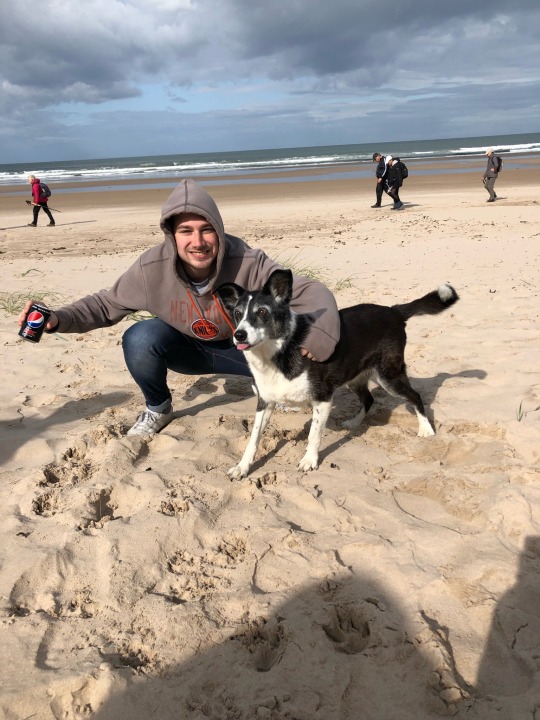
Dogs have played an important role in the history of human civilization and were among the first domesticated animals. They were important in hunter-gatherer societies as hunting allies and bodyguards against predators. When livestock were domesticated about 7,000 to 9,000 years ago, dogs served as herders and guardians of sheep, goats, and cattle. Although many still serve in these capacities, dogs are increasingly used for social purposes and companionship. Today dogs are employed as guides for the blind and disabled or for police work. Dogs are even used in therapy in nursing homes and hospitals to encourage patients toward recovery. Humans have bred a wide range of different dogs adapted to serve a variety of functions. This has been enhanced by improvements in veterinary care and animal husbandry.
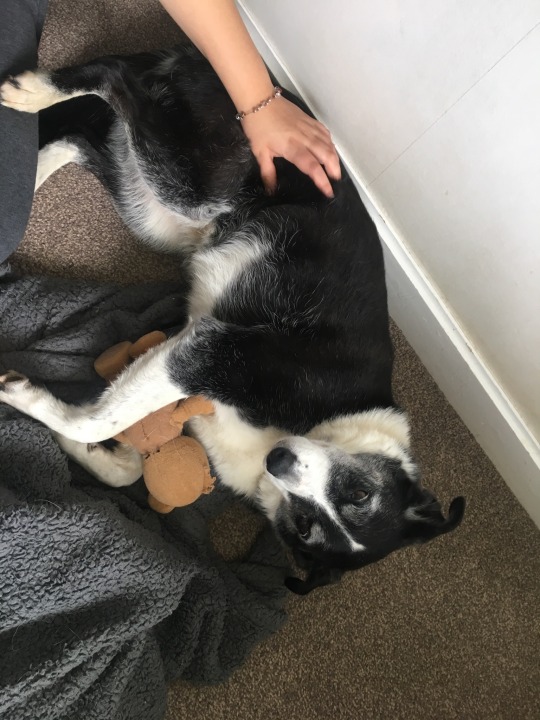
Ancestry
Paleontologists and archaeologists have determined that about 60 million years ago a small mammal, rather like a weasel, lived in the environs of what are now parts of Asia. It is called Miacis, the genus that became the ancestor of the animals known today as canids: dogs, jackals, wolves, and foxes. Miacis did not leave direct descendants, but doglike canids evolved from it. By about 30 to 40 million years ago Miacis had evolved into the first true dog—namely, Cynodictis. This was a medium-size animal, longer than it was tall, with a long tail and a fairly brushy coat. Over the millennia Cynodictis gave rise to two branches, one in Africa and the other in Eurasia. The Eurasian branch was called Tomarctus and is the progenitor of wolves, dogs, and foxes.

The timing and location of dog domestication is less clear and has been a matter of significant debate, but there is strong genetic evidence that the first domestication events occurred somewhere in Central Asia before 15,000 years ago. Some genetic studies have suggested that wolves were domesticated 16,300 years ago to serve as livestock in China. Other genetic studies, however, have suggested that dog domestication began as early as 18,800–32,100 years ago in Europe or that early dogs dating from about 12,000 to 14,000 years ago came from a small strain of gray wolf that inhabited what is now India. Thereafter this wolf—known as Canis lupus pallipes—was widely distributed throughout Europe, Asia, and North America. However, one genetic study that compared the DNA of dogs and wolves inhabiting areas thought to have been centres of dog domestication suggests that dogs and modern wolves belong to separate lineages that share a common ancestor. It is also possible that some of the dogs of today descended not from the wolf but rather from the jackal. These dogs, found in Africa, might have given rise to some of the present native African breeds. A genetic study examining the migration of dogs to the Americas revealed evidence that dogs did not accompany the first humans to the New World more than 15,000 years ago; the study suggested that dogs came to the Americas only 10,000 years ago.

No matter what their origins, all canids have certain common characteristics. They are mammals that bear live young. The females have mammary glands, and they suckle their offspring. The early breeds had erect ears and pointed or wedge-shaped muzzles, similar to the northern breeds common today. Most of the carnivores have similar dental structures, which is one way paleontologists have been able to identify them. They develop two sets of teeth, deciduous (“baby”) teeth and permanent teeth.

It is likely that wild canids were scavengers near tribal campsites at the same time that ancient humans discovered a hunting partner in the animals that ventured close by. In ancient Egypt, dogs were thought to possess godlike characteristics. They were pampered by their own servants, outfitted with jeweled collars, and fed the choicest diet. Only royalty was permitted to own purebred dogs, and upon the death of a ruler his favourite dog was often interred with him to protect him from harm in the afterlife.

Illustrations of dogs dating from the Bronze Age have been found on walls, tombs, and scrolls throughout Europe, the Middle East, and North America. Often the dogs are depicted hunting game with their human counterparts. Statues of dogs guard the entrances to burial crypts. In many cases these dogs clearly resemble modern canines. Such relics are indelible testimony to the importance that humans have given to the dog throughout the ages.
Research from: https://www.britannica.com/animal/dog/Teeth
0 notes
Photo

Origine du chien
La théorie du chaînon manquant; un chien primitif géniteur de toutes les races
n’est pas fondée.
Pas plus que l’hypothèse d’une double origine (les chiens des régions froides
descendraient du loup et ceux des régions chaudes du chacal doré).
D’après des tests génétiques, le loup est en toute probabilité l’ancêtre du chien.
Il y a environ 30 millions d’années, la première créature présentant quelques
similitudes le chien est le Cynodictis, une sorte de mangouste avec un long
museau. Les plus anciens fossiles
de Canidés ont été retrouvés en Amérique du Nord et remontent
à cette période. Puis vint Canis devenu Canis lupus (le loup) voici 300 000 ans.
Descendants de ce dernier, les premiers chiens ont fait leur apparition il y a
12 000 ans. Mais de laquelle de ces trois espèces sauvages :
loup, chacal ou coyote est issu notre
Canis familiaris, apparu en association étroite avec l’homme il y a un peu plus
de dix milles ans.
Les spécialistes, vers la fin des années 70, se sont unanimement prononcés
faveur du loups à la suite de la découverte en Asie de fossiles de chiens
s’apparentant à une variété loup de petite taille: Canis lupus chanco.
Le chien actuel est donc né en Orient. Le loup est apprivoisé par l’homme du
paléolithique.
La domestication s’est faite par étapes avec l’apprivoisement de louveteaux, et
la reproduction d’animaux fidélisés parmi les humains. Le phénomène s’est
étalé sur plusieurs milliers d’années, et a gagné les cinq continents.
Le Canis lupus aurait donné naissance à 4 types :
– Canis familiaris Leinieri ancêtre des lévriers.
– Canis familiaris Matris Optimae qui a donné les races bergères.
– Canis familiaris Intermedius (10.000 ans avant J-C) ancêtre des épagneuls
griffons et spitz.
– Canis familiaris Inostranzewi qui a donné les molosses, dogues, bouviers.
Les canidés comptent aujourd’hui 15 genres et 35 espèces qui rassemblent
les loups, chacals, coyotes et chiens, plus que dans toutes les autres espèces
animales. L’espèce canine se caractérise
par une grande diversité de taille et de poids.
Records
– le plus lourd : Mastiff de 155 kg
– le plus grand : Irish Wolfhound de 106 cm au garrot
– le plus petit : Yorkshire Terrier de 6,3 cm au garrot pour un poids de 113g
– le plus fort : Dogue allemand qui a tiré une charge de 3,4 tonnes
– le plus vieux : bâtard de 29 ans et 5 mois
– le meilleur sauteur en hauteur : Berger allemand avec 3,58 m de haut
– le meilleur sauteur en longueur : Lévrier avec 9,20 m; les plus grandes
portées:
23 chiots par une femelle Saint Bernard, Foxhound et Dogue allemand.
Ces espèces peuvent toutes se reproduirent entre elles car elles ont la même
formule chromosomique.
L’homme a sélectionné des types de chiens adaptés à des utilités différentes
(chiens de course, de trait, de garde, de berger, de compagnie, de chasse, …)
La France reconnaît plus de 300 races de chiens.
Aujourd’hui, la France compte environ 8 millions de chiens (28% de la
population ont au moins 1 chien) sur son territoire ce qui le met au premier rang
des pays européens avec par ordre de préférence : Caniche, bâtard, Berger
allemand, Yorkshire et Labrador, épagneul breton.
0 notes
Text
Wacky Raccoons!
And to finally complete our three week long forest creatures unit, here come raccoons!
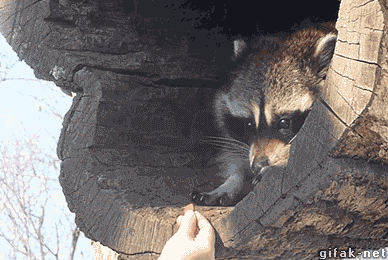
Raccoons, aka Procyon lotor, are well known in the southern united states. They eat out of our garbage cans at night, and steal farmers’ crops. Raccoons can exist in just about any place between the top of Florida and Alaska, excluding coniferous places and places in the United States too far west. They recently have been introduced to spots of Europe and Japan.

A typical raccoon diet is just about anything. What they eat often depends on where they live. Raccoons are omnivores and scavengers, so they eat fruits, veggies, birds, insects, our trash, you name it!

Class: Mammalia
Order: Carnivora
Family: Procyonidae
Genus: Procyon
Species: Procyon lotor

Alright guys, this is where it gets kind of weird. The raccoon social behavior is very strange! Though once thought to be extremely solitary, new research evidence shows otherwise. Raccoons are incredibly smart (and good with their hands too!) and so scientists grouped them into three different social classes.
1. The male group - this group consists of a few unrelated males sharing a couple miles of space for protection from their predators.
2. The female group - females that are not pregnant will typically live either alone, or in a tight knit group of other gals like her.
3. The pregnant group - male raccoons are often violent towards unrelated kits, that’s the name for a baby raccoon, and will try to attack them.

Speaking of pregnant raccoons, the mating season is anywhere between late winter to early spring. The male will find several females to mate with over about a four day period, but the female will only mate with one, unless she doesn’t become impregnated from that male. Then she will move on.

Females are typically ready to reproduce at about one year old. The gestation period once she does get pregnant is about sixty days. She weans her 2-5 kits off after about half a month.

Raccoons evolved from the same canine species as dogs, bears, and weasels. But their real evolution comes from the genera Phlaocyon and Cynodictis from the Lower Miocene or Oligocene (link to this down below!!)
Aaaannnnddd that wraps up this unit!! bye yall, see you next week on etta’s science!!
~ links ~
http://www.pbs.org/wnet/nature/raccoon-nation-raccoon-fact-sheet/7553/
http://www.havahart.com/raccoon-facts
http://www.esf.edu/aec/adks/mammals/raccoon.htm
http://getraccoonsout.com/raccoon-social-behavior/
http://online.sfsu.edu/bholzman/courses/Fall00Projects/raccoon.html
0 notes
Photo
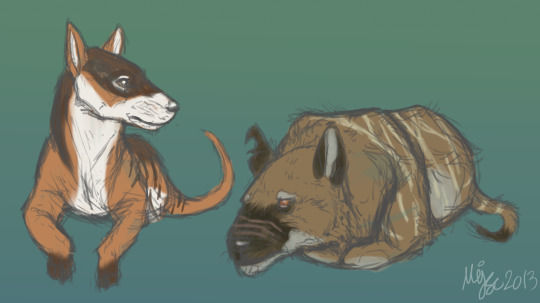
I made this like.. 2 months ago? :D I can't really remember..
9 notes
·
View notes
Text
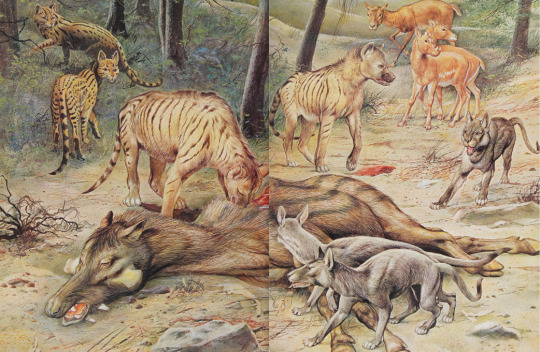
The Evolution of the Mammals. Written by L. B. Halstead. Illustration by Sergio. 1978.
Internet Archive
#prehistoric#prehistoric mammals#dinictis#cynodictis#hyaenodon#protoceras#entelodonts#archaeotherium#animal death#predation#fave#Sergio
141 notes
·
View notes
Text
Paleo Pixels Masterlist
Want to make a suggestion but not sure if I've already drawn it? Well wonder no further! Here is the masterlist of every paleo pixel I've done so far.
Dinosaurs
Daspletosaurus - Styracosaurus -Yi-Qi - Deinocherius - Sinosauropteryx - Jinyunpelta - Microraptor - Carnotaurus - Anklyosaurus - Spinosaurus - Deinonychus - Pachyrhinosaurus - Parasaurolophus - Acrocanthosaurus - Kryptops - Brachiosaurus - Maip
Non-Dinosaurs
Quetzalcoatlus - Coelacanth - Dimetrodon - Anteosaurus - Cotylorhyncus - Rhyamphorhynchus - Dunkleosteus - Gorgonopsid - Kaprosuchus - Basilosaurus - Cynodictis - Australian Lungfish
Invertebrates
Gryphaea - Plectronoceras - Balhuticaris - Aegirocassis - Opabinia - Anomalocaris - Hallucigenia
23 notes
·
View notes
Photo
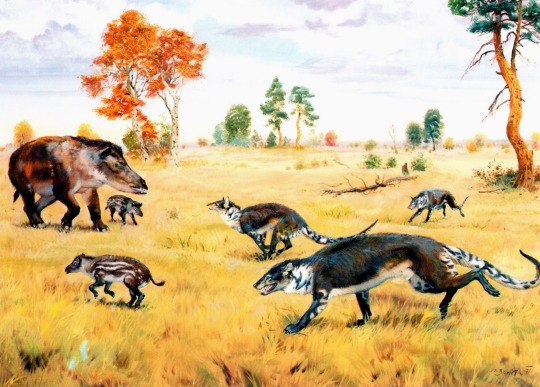
Cynodictis and Bothriodon
Zdeněk Burian
#prehistoric#prehistoric mammals#amphicyonidae#cynodictis#anthracotheriidae#bothriodon#Zdeněk Burian#fave
257 notes
·
View notes